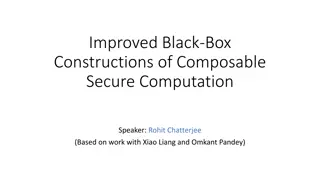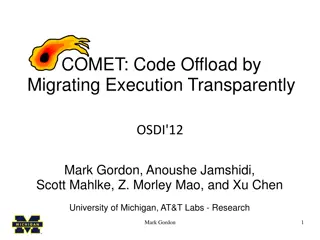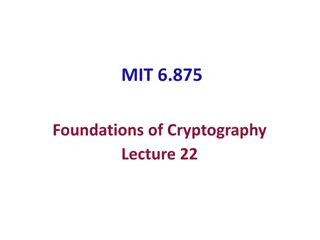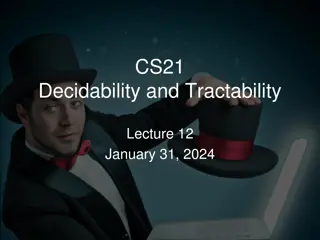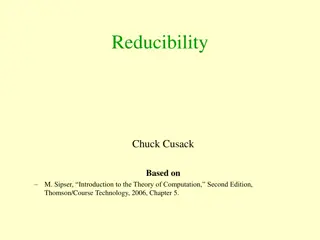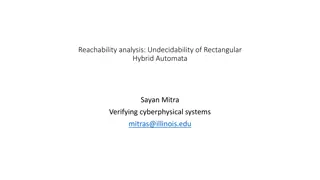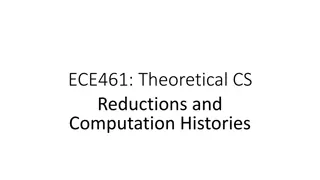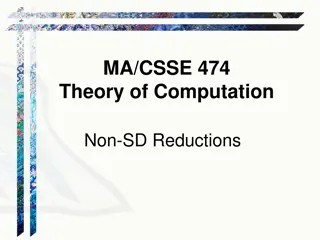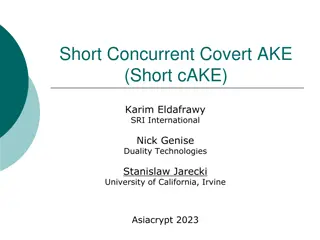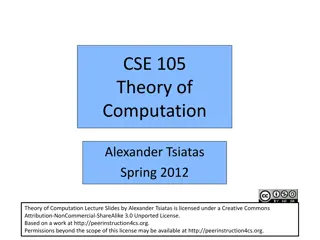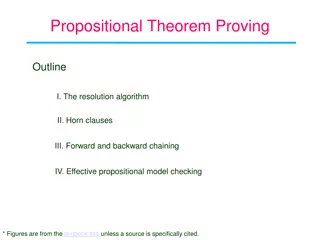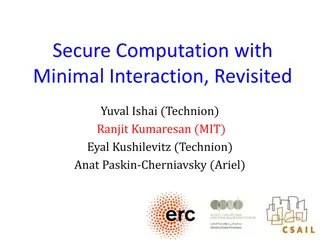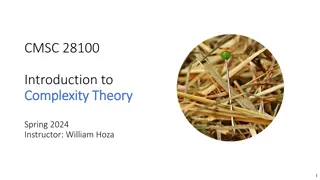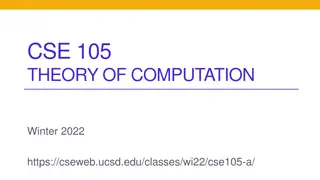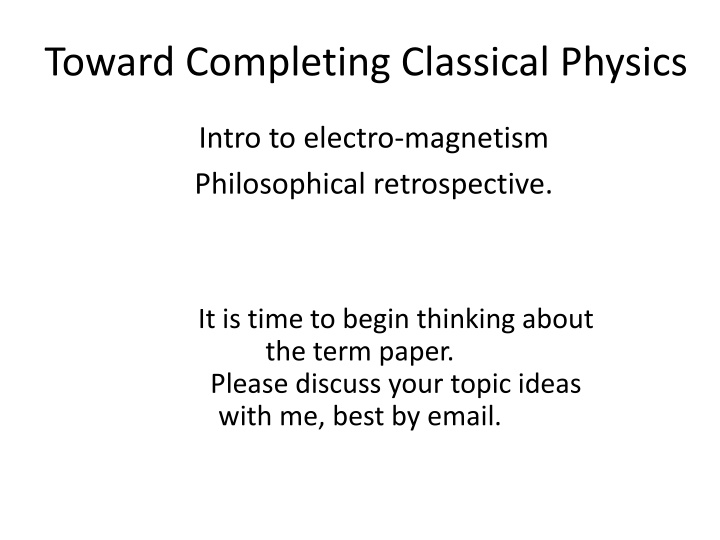
Proving Undecidability and T-Unrecognizability: Computation History & LBA
Today's lecture covers the Computation History Method for proving undecidability, focusing on the undecidability of the Post Correspondence Problem, Linearly Bounded Automata (LBA), and undecidable problems related to LBAs and CFGs.
Download Presentation

Please find below an Image/Link to download the presentation.
The content on the website is provided AS IS for your information and personal use only. It may not be sold, licensed, or shared on other websites without obtaining consent from the author. If you encounter any issues during the download, it is possible that the publisher has removed the file from their server.
You are allowed to download the files provided on this website for personal or commercial use, subject to the condition that they are used lawfully. All files are the property of their respective owners.
The content on the website is provided AS IS for your information and personal use only. It may not be sold, licensed, or shared on other websites without obtaining consent from the author.
E N D
Presentation Transcript
Toward Completing Classical Physics Intro to electro-magnetism Philosophical retrospective. It is time to begin thinking about the term paper. Please discuss your topic ideas with me, best by email.
Electro-Magnetism The fundamental force involved in most experiences is electro-magnetism. We won't follow the historical development (Franklin, Coulomb, Ampere, Faraday, Maxwell ) but will just give the result, which bears a strong resemblance in general form to gravity. Electricity: There is a property of each object called its charge, q. The electric force between two charged objects is given by: which should remind you of the law for gravity: q q F = 1 r 2 2 GMm F = 2 r There's another force, magnetism, between electrically charged objects with some velocity: Magnetism: 2 r ( ) q q v v r 2 1 = 1 2 F Is Galileo s relativity gone?
Action at a Distance and Fields One of the most worrisome features of Newton s theory of gravity was that it required objects to affect each other across empty space. N thought that there must be some mediator, but he did not know what it was. For electricity and magnetism it became useful to distinguish the source of an effect from the object of its effection . For all three forces (gravity, electricity, and magnetism), the effect of an object on any other object can be written as the product of two terms, one depending only on the first object (called the source) and the other only on the second object. GMmr r = = ( ) g r F gm a Gravity: Electricity: Magnetism: 2 1 2 q q r r q q v = = ( ) / F Eq a E r q m 2 2 2 ( 2 ) r v 2 2 q v m = = 1 2 2 1 ( ) F 2 2 q v B a B r r g, E, and B are called the gravitational, electrical, and magnetic fields, respectively. The field is a useful mathematical device, but are these fields real ? How to tell? In order to be real, they ought to have some independent manifestation, besides just giving a simple way to calculate forces between objects.
Electromagnetism and the Ether Electric and magnetic fields were discovered in the 19th century to have two properties which gave support to their reality. Faraday discovered that if the magnetic field B varies with time, this gives rise to an electric field E. So, there is some behavior of E and B which is not just a re-description of forces between particles. James Maxwell discovered (1864) that changes in E give rise to B as well. That implies that E and B can exist in the absence of any electrical charges (i.e., no sources). Maxwell unified the description of electricity and magnetism and claimed that light is a wave composed of oscillating E and B fields. He predicted the existence of other electromagnetic waves, which were observed by Hertz. Three previously distinct phenomena have been subsumed by a single theory.
Two problems for Maxwell's E-M theory 1. When an EM wave propagates through the vacuum, what is the medium? What is oscillating? The equations that describe electrodynamics violate Galilean invariance. This violation should show up in the wave motion. Is the speed of light uniform only constant with respect to the medium? 2. The medium was dubbed the luminiferous ether. It was defined as being the stuff of which E-M fields are the disturbances.
Galileos Relativity Gone? Did Galilean relativity apply only to some mechanical laws, but not really to the laws of physics as a whole? Is there some other relativity that works? Isn't that possibility just what Newton's philosophical ideas about absolute space had suggested? If we assume some ether which is the medium in which E-M effects are carried, might it not also provide the only reference frame in which the Maxwell s electromagnetic laws are true? (i.e., only one at rest wrt the ether) plus maybe provide the medium Newton wanted for gravity? Would we then have all spatial properties be purely relational, but against a background of simple ether properties which mimic Euclidean space?
Retrospective on Classical Physics We have now completed an introduction to the classical synthesis of physics. The common view was that in all important questions, physics was complete. Lord Kelvin, in ca 1900, made a famous speech declaring that physics was basically done, except for two little "dark clouds on the horizon": 1. Black-body radiation 2. The Michelson-Morley experiment. Before we encounter stormy weather, let's try to sum up classical physics and its relation to traditional philosophical questions.
The physics (as of 1900) Nature consists of particles and fields, imbedded in time and space. Elementary ingredients of the classical description: Position and time are both undefined quantities. One cannot explain them to someone who does not already have a mental construct. Try to imagine a universe with two time dimensions. Mass is another undefined quantity. Its mathematical behavior is defined by Newton s second law together with specific force laws, and some rule for measuring accelerations. We still need some implicit understandings to connect all these constructs to actual experiences. The influence of the particles and fields on each other is described by definite deterministic equations. Not all the particles and fields are known. There are all sorts of rule-of-thumb forces, but only G and E-M look fundamental None of the detailed properties of chemistry, materials, etc., are accounted for. They might require some new field, etc. on a small scale. There are some unifying conservation laws: Momentum, angular momentum, energy, mass, electrical charge There are some symmetries Space translation, rotation, Time translation, mirror-image (parity), Time reversal (but, oddly, only on a microscopic level) Galilean relativity (but not for electromagnetism!)
Galilean Symmetry, explicitly There are rules for converting coordinates of events from one frame to another. E.g. simple origin shifts: x'=x-x0 or t'=t-t0 Or Galilean transforms: If two events happen at the same time in one frame, must they happen at the same time in another? If two events happen at the same place in one frame, must they happen at the place time in another? = x x vt ' = y y ' = z z ' = t t '
Philosophical pause: Reductionism (now that we have some fundamental laws) Are all causal events reducible to elementary mechanical causality? What about the standard "ranking" Highest level Deepest level Psychology Biology Chemistry Physics Is each level "reducible" to the deeper level? What does reducible mean?
Reductionism There are many flavors of reductionism, and failure to distinguish among them leads to many arguments at cross-purposes. Very strong reductionism: All phenomena will be understood as consequences of a small set of fundamental laws: a genuine theory of everything. Weaker reductionism: All phenomena are reducible "in principle" to a small set of fundamental rules. But what's the operational test of whether that's correct, if the reduction process is hopelessly complicated? In-between reductionism: Reducible "in principle" means that phenomena at each level must at least be consistent with the rules at lower levels. Often the lower level rules provide insight into the higher-level processes, occasionally the lower-level rules let us predict higher level phenomena. 1. 2. 3. The question of whether the layers of causation have a final deepest layer is NOT logically tied to the question of whether going deeper provides important insight to the higher levels. Watch out for many pop-philosophers who conflate these two questions.
Explicit Philosophy Modern physics will shake up our ideas about reality. Let's prepare by a quick review of some classical philosophical views. Hume and Kant: (mid to late 18th century) Hume (Treatise on Human Nature): One can only learn about reality through experience. Causation itself is a mental construct, not inherent in phenomena themselves. However, in pointing out that the idea of induction itself cannot be inductively confirmed (only disconfirmed), Hume implicitly indicated a way in which we seem to approach the world with "hard-wired" prior assumptions. Note two problems with induction: at the deepest level, the argument for it is circular the categories to be used in extrapolating toward the future (grue?) are not specified by any logical principle Kant Critique of Pure Reason): agreed with most of this, but argued that there are two valid forms of a priori knowledge. One is the reasoning facility (logic) by which we analyze our experiences. The other is mathematics, such as geometry. It was known, however, that as a logical system, Euclidean geometry was not unique, but only one geometry of a larger family. Kant believed it to be the only conceivable actual geometry of the world.
Views of Reality: a spectrum The ontological spectrum IdealismRealism Berkeley Mach Plato postmodernists? Hume Planck Einstein Joe 6-pack The common man in the street There are definite events independent of observation. Our senses record these events. Theories can represent genuine causal patterns inherent in the events. Generally, the features we use to describe things, e.g. size, time , are inherent in the events themselves. The world consists of collections of 'things'. Einstein There's a definite real world, of which we are observers, and also parts. But we can't count on even the deepest features to be as they seem. The world follows simple mathematical laws. Planck (Realism, not entirely naive): The goal of physics is a unified world picture. Laws must be independent of the observer. The picture must be consistent. Simplicity is a means to get to a true, general picture, not an end.
Views of Reality: a spectrum Plato The sensed world is an ephemeral approximation to the true world of ideal essences. Reason tells us more about that true world than mere sensation can provide. Hume (skepticism): Whatever we claim about reality, only senses are available. There is no logical basis for induction. Nevertheless we all must accept it in practice. Mach (a particularly subjective version of positivism): Sensory impression is primary. Substances are patterns of impressions. No eternal laws. (E.g., atoms aren t real.) Notice that Planck and Mach both recognize that we have nothing but sense impressions and the need to organize them simply. Planck implicitly assumes that the sense impressions come from somewhere, and have properties that make them fit into simple patterns. Mach assumes there's something arbitrary about the patterns we find, so that no pattern should be expected to be stable.
Views of Reality: a spectrum Berkeley (almost solipsism): You are only aware of your own thoughts. External reality is an unnecessary hypothesis. (This has become a popular academic position again. Does anyone really believe it?) However, to account for the similarity of perceptions of different people (rather than claim we are all simply thoughts of his) Berkeley invokes the mind of God, in which he claims we all partake. But: Why is it better to postulate "God's mind" than to go with the na ve postulate of reality? If it is meaningless to think of a reality without mind, why does the world in our minds have so much evidence of evolution, death etc., just as if reality went its way independent of our minds? Traditional answer to Berkeley: If a stone isn't real, go ahead and kick it. Russell's answer to B: If the world is all in my imagination, why does it include the parts of Whitehead's book which I don't understand?
Progress? One passage of Democritus that does survive is a dialogue between the intellect and the senses. The intellect starts out, saying: "By convention there is sweetness, by convention bitterness, by convention color, in reality only atoms and the void." In my book, this one line already puts Democritus shoulder-to- shoulder with Plato, Aristotle, or any other ancient philosopher you care to name. But the dialogue doesn't stop there. The senses respond, saying: "Foolish intellect! Do you seek to overthrow us, while it is from us that you take your evidence? Scott Aaronson
Some ideas people argue about fortunately, we have a busy semester and don't have to argue about them here, unless there's time and interest! Dualism: It is often assumed that Mind and Matter are two separate categories. That runs into some obvious problems, in that all the minds of which we are aware are obviously strongly affected by their material underpinnings. (alcohol ) Furthermore, minds evolved in a seemingly continuous way from matter that seems mindless. Is there a way to get around the apparent dualism? Can mind affect matter and vice versa? If so, in what way are they distinct? Why not just describe mind as a particular organization of matter? Berkeley says everything is mind. (no matter) But he then has to add assumptions about the universal mind that, in effect, are equivalent to assuming a material world. Russell says everything is matter. (never mind) How does one test this claim? Russell defines matter as "that which obeys the laws of physics . Which laws? We still don't have all the laws! If we say that the laws of physics are the things needed to describe how everything behaves, isn t our argument circular?
Materialism and Mentalism: The crude form of materialism: All things are made of solid constituents. Each constituent is described by a set of numbers (e.g., position). These are the primary properties. Events are relations between things. Secondary properties are the large-scale descriptions of collections of and interactions between the primaries. The sophisticated form: Russell: That which obeys the laws of physics. But since those laws aren't fully set, matter becomes anything that fits into some coherent laws. So the question of whether everything is "matter' ceases to be a question about what everything is "made of" but rather a question about what types of laws are universally obeyed by phenomena. Implicitly, the materialist view is that the deepest laws will continue to be of a mathematical form, i.e. in the broad class described by Galileo, and will not revert to the more directly value-laden Aristotelian form. A real question (non-semantic): Is there a special set of laws needed to describe mind, or are all mental processes outcomes of the same laws that affect other matter? Obviously, there are mental phenomena which are easiest to describe using special constructs, but the question is whether these are complicated outgrowths of the ordinary physical laws or violations of them.

